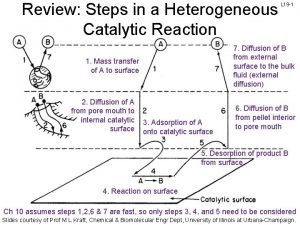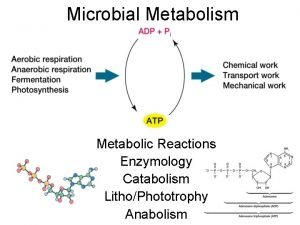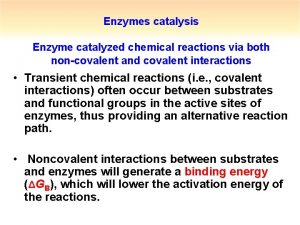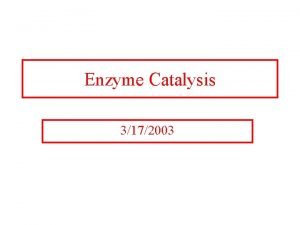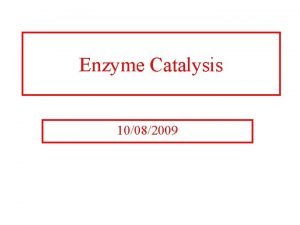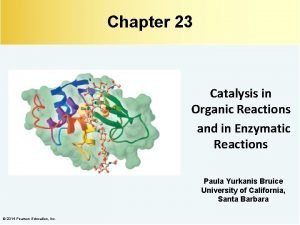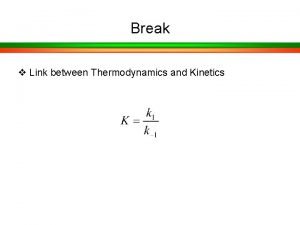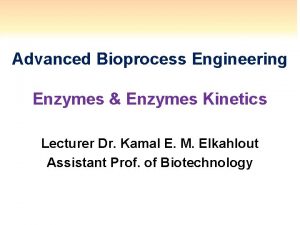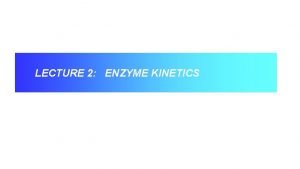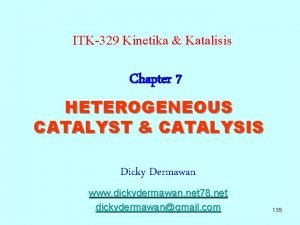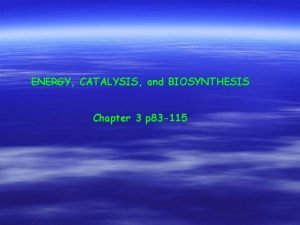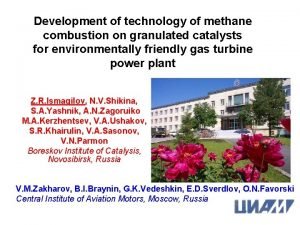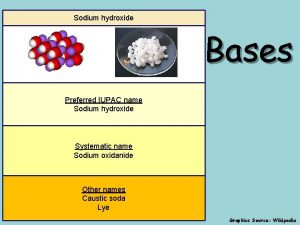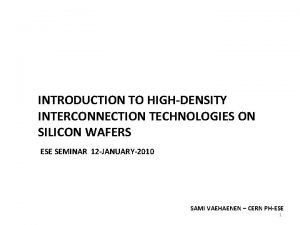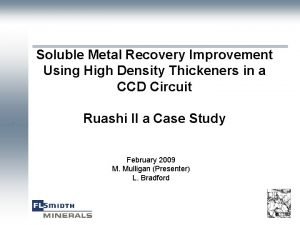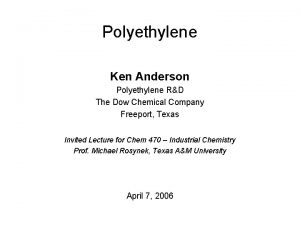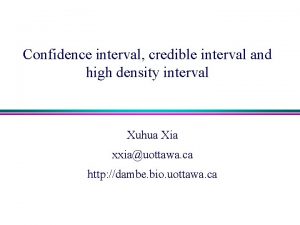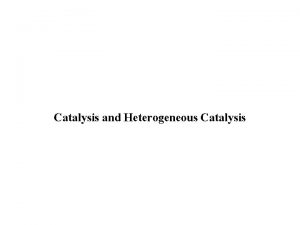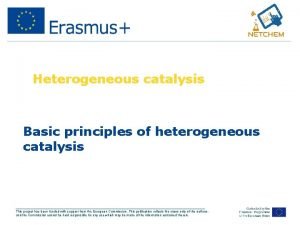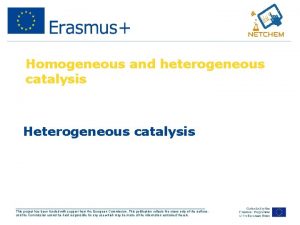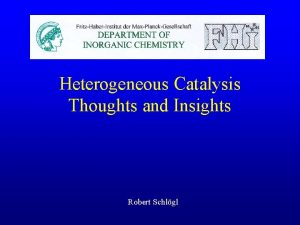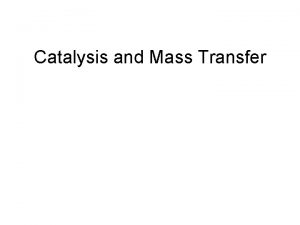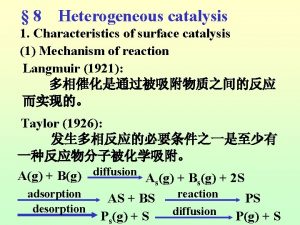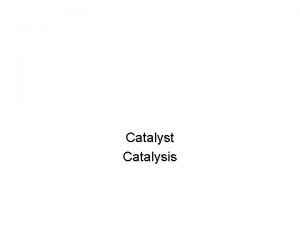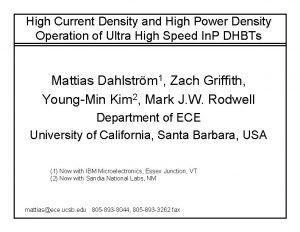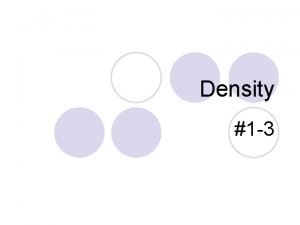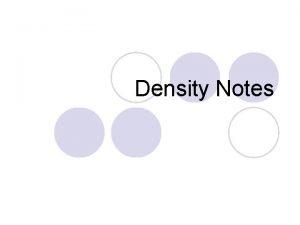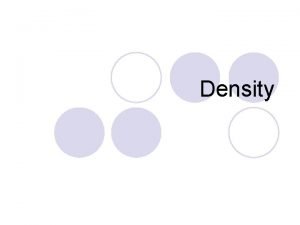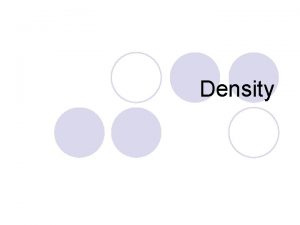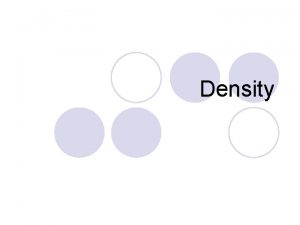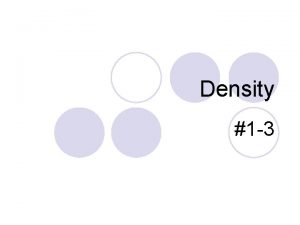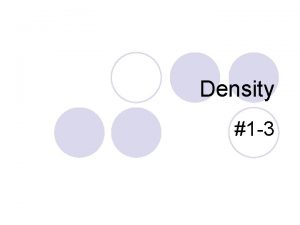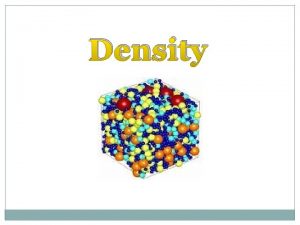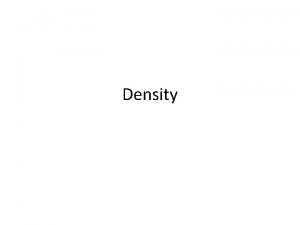Catalysis with High Density Molecular Monolayer for Organic








![Catalytic Dehydrogenative Silylation of Alcohols catalyst [Rh. Cl(C 2 H 4)2]2 Au (in CH Catalytic Dehydrogenative Silylation of Alcohols catalyst [Rh. Cl(C 2 H 4)2]2 Au (in CH](https://slidetodoc.com/presentation_image/6e2549fbb2cc8f644dfa3c7fdf9a5c5d/image-9.jpg)







![Rh Complexiation with [Rh. Cl(cod)]2 top view side view About 50% complexation between Rh Rh Complexiation with [Rh. Cl(cod)]2 top view side view About 50% complexation between Rh](https://slidetodoc.com/presentation_image/6e2549fbb2cc8f644dfa3c7fdf9a5c5d/image-17.jpg)
![Rh Complexiation with [Rh. Cl(CO)2]2 Rh density (ICP-MS) 0. 66 nmol/cm 2 (4. 0 Rh Complexiation with [Rh. Cl(CO)2]2 Rh density (ICP-MS) 0. 66 nmol/cm 2 (4. 0](https://slidetodoc.com/presentation_image/6e2549fbb2cc8f644dfa3c7fdf9a5c5d/image-18.jpg)

![C=C Hydrogenation of , -Carbonyl Compounds enone / Rh = 72, 000 [Rh. Cl(CO)2] C=C Hydrogenation of , -Carbonyl Compounds enone / Rh = 72, 000 [Rh. Cl(CO)2]](https://slidetodoc.com/presentation_image/6e2549fbb2cc8f644dfa3c7fdf9a5c5d/image-20.jpg)





















- Slides: 41

Catalysis with High Density Molecular Monolayer for Organic Transformation Kenji Hara Department od Applied Chemistry, School of Engineering, Tokyo University of Technology

2

Catalysts in Our Daily Life Automobile gas purification (Elimination of NOx) Internal wall in microwave oven (Decomposition of CO and bad smells) Petrochemical Plants (From oil to gasoline, plastic, rubber etc. ) 3

Formal Classification of Metal-Involving Catalyst Homogeneous Catalyst · Designability · Diversity Solid-Supported Catalyst Mixed-Monolayer Catalyst Heterogeneous Catalyst · Separation, Recovery · Stability Monolayer Catalyst

Densely Packed Monolayer Catalysts on Flat Surface Enhancement of catalyst turnover; but not always due to their high densities. LB film on glass thiolate monolayer on Au monolayer on Si. O 2

Chem. Commun. 2007, 4280. Chem. Lett. 2006, 35, 870. Angew. Chem. Int. Ed. 2008, 47, 5627. Chem. Commun. 2014, 5046.

Self-Assembled Monolayer of Alkanethiol on Gold Surface Self-Assembled Monolayer (SAM)

Compact Phosphine —Key Molecule for Unique Catalysis in Monolayer— Newly-Designed Phosphine Reported Metal-Phosphine Monolayer on Au surface Au Org. Lett. 2003, 5, 2671. Angelici et al. Can. J. Chem. 2001, 79, 578.
![Catalytic Dehydrogenative Silylation of Alcohols catalyst Rh ClC 2 H 422 Au in CH Catalytic Dehydrogenative Silylation of Alcohols catalyst [Rh. Cl(C 2 H 4)2]2 Au (in CH](https://slidetodoc.com/presentation_image/6e2549fbb2cc8f644dfa3c7fdf9a5c5d/image-9.jpg)
Catalytic Dehydrogenative Silylation of Alcohols catalyst [Rh. Cl(C 2 H 4)2]2 Au (in CH 2 Cl 2) 5 x 5 mm 2 “Recyclable” TON = 4, 100 K. Hara et al. Angew. Chem. Int. Ed. 47, 2008, 5627. TON = 10, 000 “Deactivated” TON = catalyst turnover number per Rh atom

Catalytic Dehydrogenative Silylation of Alcohols —Competitive Reaction between 1゚ vs 2゚ Alcohols— catalyst Au Substrate/Catalyst Yield (%) 1° selectivity (%) 86, 000 67 >99. 5 (in CH 2 Cl 2) 200 100 73 Au 86, 000 44 80

Catalytic Dehydrogenative Silylation of Alcohols —Competitive Reaction between 1゚ vs 2゚ Alcohols— catalyst Au Catalyst Tunover Number 1° selectivity (%) 58, 000 >99. 5 46 98

Homogeneous Catalyst · Designability · Diversity Au Monolayer Catalyst

Chem. Commun. 2007, 4280. Chem. Lett. 2006, 35, 870. Angew. Chem. Int. Ed. 2008, 47, 5627. Chem. Commun. 2014, 5046.



XPS and ICP-MS Analyses of Metal Diisocyanide Monolayer Rh 3 d 5/2 Intensity (a. u. ) N 1 s Intensity (a. u. ) Binding energy (e. V) The longer linker molecule, the more ordered structure. Cl 2 p
![Rh Complexiation with Rh Clcod2 top view side view About 50 complexation between Rh Rh Complexiation with [Rh. Cl(cod)]2 top view side view About 50% complexation between Rh](https://slidetodoc.com/presentation_image/6e2549fbb2cc8f644dfa3c7fdf9a5c5d/image-17.jpg)
Rh Complexiation with [Rh. Cl(cod)]2 top view side view About 50% complexation between Rh and CN Density of isocyanide: About 0. 7 nmol/cm 2 (4 × 1011 cm-2)
![Rh Complexiation with Rh ClCO22 Rh density ICPMS 0 66 nmolcm 2 4 0 Rh Complexiation with [Rh. Cl(CO)2]2 Rh density (ICP-MS) 0. 66 nmol/cm 2 (4. 0](https://slidetodoc.com/presentation_image/6e2549fbb2cc8f644dfa3c7fdf9a5c5d/image-18.jpg)
Rh Complexiation with [Rh. Cl(CO)2]2 Rh density (ICP-MS) 0. 66 nmol/cm 2 (4. 0 × 1011 cm-2) top view N : Rh : Cl = 2. 0 : 1. 3 : 1. 6 side view About 100% complexation between Rh and CN Density of isocyanide: About 0. 7 nmol/cm 2 (4 × 1011 cm-2)

![CC Hydrogenation of Carbonyl Compounds enone Rh 72 000 Rh ClCO2 C=C Hydrogenation of , -Carbonyl Compounds enone / Rh = 72, 000 [Rh. Cl(CO)2]](https://slidetodoc.com/presentation_image/6e2549fbb2cc8f644dfa3c7fdf9a5c5d/image-20.jpg)
C=C Hydrogenation of , -Carbonyl Compounds enone / Rh = 72, 000 [Rh. Cl(CO)2] Catalyst Au Au Time (h) 12 12 12 Conversion (%) 0 100 32 100 45 Selectivity (%) -- 97 87 57 20 35 (c-hexanone) 20 Chem. Commun. 2014, 5046.

C=C Hydrogenation of , -Carbonyl Compounds Conversion (%) Selectivity (%) 100 100 69 98 100 69 91 Chem. Commun. 2014, 5046.

Chem. Commun. 2007, 4280. Chem. Lett. 2006, 35, 870. Angew. Chem. Int. Ed. 2008, 47, 5627. Chem. Commun. 2014, 5046.

Homogeneous Catalyst · Designability · Diversity Mixed-Monolayer Catalyst Heterogeneous Catalyst · Separation, Recovery · Stability Monolayer Catalyst

Periodic Mesoporous Organosilica (PMO) S. Inagaki et al. , Nature, 416, 304 (2002). Uniform mesopore (2 -30 nm) consisting of crystal-like ordered arrays of organic moiety bridged by siloxane bond S. Inagaki et al. , Angew. Chem. Int. Ed. 50, 11667 (2011). Dr. Shinji Inagaki

SEM/TEM Images of BPy-incorporated PMO J. Am. Chem. Soc. , 2014, 136, 4003.

Structure of BPy-incorporated PMO 2, 2’-bipyridine units are densely arranged in mesopore channel. Si-O-Si 2, 2’-Bipyridine BPy-PMO 0. 44 nm 3. 8 nm 1. 16 nm J. Am. Chem. Soc. , 2014, 136, 4003. TOYOTA CRDL, INC.

Catalytic Aromatic Borylation by Ir-immobilized PMO 80℃, 12 h Waki, M. ; Maegawa, Y. ; Hara, K. ; Goto, Y. ; Shirai, S. ; Yamada, Y. ; Mizoshita, N. ; Tani, T. ; Chun, W. -J. ; Muratsugu, S. ; Tada, M. ; Fukuoka, A. ; Inagaki, S. J. Am. Chem. Soc. , 2014, 136, 4003.

Immobilization of Ru Complex on PMO (Ru/surface bpy = 1 ) THF reflux, 3 h BPy-PMO S. Inagaki et al. , J. Am. Chem. Soc. , 136, 4003(2014). Ru: 15 mol% (per surface bpy from EDX) 0. 30 mmol g-1 (3. 0 wt%) Ru-BPy-PMO

Selective Alkane Oxidation Catalyzed by Ru-immobilized PMO Chem. Eur. J. , 2015, 21, 15453. (Cover Page)

Selective Alkane C-H Bond Oxidation ① Selective oxidation of tertiary C-H bond of adamantane Ru-BPy-PMO Pharmaceutical intermediate Fine chemicals for functional materials ② Stereoselective oxidation C-H bond of cis-decalin Ru-BPy-PMO Applicable for selective oxidation of steroids

Fe-immobilized Periodic Mesoporous Organosilica in Catalytic Synthesis of Amino Alcohols Pushkar Shejwalker 1, 2, Kenji Hara 1, 2*, Yoshifumi Maegawa 3, Shinji Inagaki 2, 3 Department od Applied Chemistry, School of Engineering, Tokyo University of Technology 2 JST/ACT-C 3 Toyota Central R&D Labs. Inc. 1 *haraknj@stf. teu. ac. jp

Amino Alcohol Synthesis Catalyzed by Fe-immobilized PMO Catalyst mol% Time (h) Yield (%) Fe(OTf)2 5. 0 18 0 (+byproducts) Fe(bpy)3 Cl 2 5. 0 18 0 Fe. Cl 2(dm. BPy) 2. 2 4 <1 Fe. Cl 2(Tri. Iso. Ph. BPy) 2. 2 4 19 Fe(OTf)2+Tri. Iso. Ph. BPy 2. 2 4 <1 (+byproducts) Fe. Cl 2 BPy-PMO 8. 9 4 36 Fe(OTf)2 BPy-PMO 4. 0 4 89 Fe(OTf)2 BPBPy-PMO 4. 0 4 59 Fe(OTf)2 BPy-PS 4. 0 4 9 BPy-PMO dm. BPy Tri. Iso. Ph. BPy BPBPy-PMO Fe-immobilization on the PMO mesopore acilitates epoxide opening with aniline. BPy-PS

Possible Mechanism of Catalysis with Fe-immobilized PMO Concerted activation with Lewis acid site on Fe and the neighboring Bronsted acid sites on pyridinium Proton transfer on pyridine Proton transfer over pyridine arrays

Homogeneous Catalyst · Designability · Diversity Mixed-Monolayer Catalyst Heterogeneous Catalyst · Separation, Recovery · Stability Monolayer Catalyst

Thiol to Isocyanide Metal-Phosphine Terminated Thiolate Metal- Diisocyanide

Periodic Mesoporous Organosilica (PMO) S. Inagaki et al. , Nature, 416, 304 (2002). Uniform mesopore (2 -30 nm) consisting of crystal-like ordered arrays of organic moiety bridged by siloxane bond S. Inagaki et al. , Angew. Chem. Int. Ed. 50, 11667 (2011). Dr. Shinji Inagaki

Collaborators & Acknowledgment Prof. Masaya Sawamura Dr. Ryuto Akiyama Collaboration Prof. Kohei Uosaki Dr. Toshihiro Kondo Dr. Satoru Takakusagi Dr. Takuya Masuda XAFS Prof. Kiyotaka Asakura Prof. W. J. Chun XPS Prof. Katsuaki Shimazu Dr. Yusuke. Yoshinaga Prof. W. J. Chun Ms. Yuriko Ishiguro

Collaborators & Acknowledgment Prof. Atsushi Fukuoka Dr. Sachin Jagtap Mr. Yoshinori Kaji Mr. Kotaro Namba Au Surface XAFS Prof. Kohei Uosaki Prof. Kiyotaka Asakura Dr. Hidenori Noguchi Prof. W. J. Chun Prof. Katsuaki Shimazu HREELS Dr. Toshikazu Kawaguchi Prof. Maki Kawai Dr. Hiroyuki Kato

Ru-Immobilized Periodic Mesoporous Organosilica as Selective Catalyst in Alkane Oxidation Kenji Hara 1, 2, 3, 4*, Nobuhiro Ishito 2, Yoshifumi Maegawa 4, 5, Shinji Inagaki 4, 5 and Atsushi Fukuoka 2, 3 School of Engineering, Tokyo University of Technology 2 Catalysis Research Center, Hokkaido University 3 Graduate School of Chemical Sciences and Engineering, Hokkaido University 4 JST/ACT-C 5 Toyota Central R&D Labs. Inc. 1

Fe-immobilized Periodic Mesoporous Organosilica in Catalytic Synthesis of Amino Alcohols Pushkar Shejwalker 1, 2, Kenji Hara 1, 2*, Yoshifumi Maegawa 3, Shinji Inagaki 2, 3 Department od Applied Chemistry, School of Engineering, Tokyo University of Technology 2 JST/ACT-C 3 Toyota Central R&D Labs. Inc. 1 *haraknj@stf. teu. ac. jp

Catalysis with High Density Molecular Monolayer for Organic Transformation Kenji Hara Department od Applied Chemistry, School of Engineering, Tokyo University of Technology
 High density low density
High density low density Decao
Decao Apoenzyme
Apoenzyme What is covalent catalysis
What is covalent catalysis What is covalent catalysis
What is covalent catalysis What is covalent catalysis
What is covalent catalysis Specific acid base catalysis
Specific acid base catalysis Specific acid base catalysis
Specific acid base catalysis Specific acid base catalysis
Specific acid base catalysis Enzyme catalyze
Enzyme catalyze Langmuir-hinshelwood mechanism heterogeneous catalysis
Langmuir-hinshelwood mechanism heterogeneous catalysis Catalysis lecture notes
Catalysis lecture notes Energy catalysis and biosynthesis
Energy catalysis and biosynthesis Catalytic combustion
Catalytic combustion Honh2 dissociation equation
Honh2 dissociation equation Covalent bond
Covalent bond Giant molecular structure vs simple molecular structure
Giant molecular structure vs simple molecular structure Zinc oxide + nitric acid → zinc nitrate + water
Zinc oxide + nitric acid → zinc nitrate + water Units of specific gravity
Units of specific gravity Linear density of fcc 110
Linear density of fcc 110 Physiological density vs arithmetic density
Physiological density vs arithmetic density Linear density of atoms
Linear density of atoms Physiologic population density
Physiologic population density Entisoil
Entisoil Introduction to high density interconnects
Introduction to high density interconnects High density thickener
High density thickener High density polyethylene
High density polyethylene High density interval
High density interval Fspos
Fspos Typiska drag för en novell
Typiska drag för en novell Tack för att ni lyssnade bild
Tack för att ni lyssnade bild Ekologiskt fotavtryck
Ekologiskt fotavtryck Varför kallas perioden 1918-1939 för mellankrigstiden?
Varför kallas perioden 1918-1939 för mellankrigstiden? En lathund för arbete med kontinuitetshantering
En lathund för arbete med kontinuitetshantering Särskild löneskatt för pensionskostnader
Särskild löneskatt för pensionskostnader Personlig tidbok fylla i
Personlig tidbok fylla i Sura för anatom
Sura för anatom Vad är densitet
Vad är densitet Datorkunskap för nybörjare
Datorkunskap för nybörjare Tack för att ni lyssnade bild
Tack för att ni lyssnade bild Att skriva debattartikel
Att skriva debattartikel Delegerande ledarskap
Delegerande ledarskap

